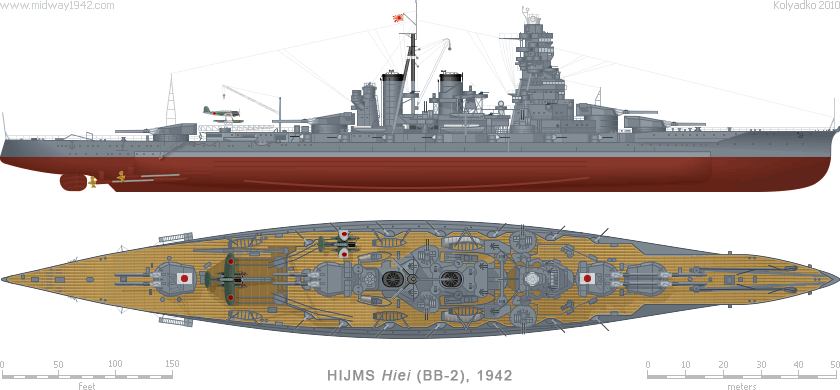
| Kongō class, 金剛型 | FAST BATTLESHIPS, 高速戦艦 | |

| Displacement: | 36,600 t (32,156 t Std) | Machinery: | 8 boilers, 4 shafts | Main Guns: | 4×2×14 in (356 mm)/45 | Main Belt: | 8-3 in | 203-76 mm | |||||||||
|---|---|---|---|---|---|---|---|---|---|---|---|---|---|---|---|---|---|
| Max Length: | 728 ft 4 in | 222 m | Max Power: | 136,000 hp | 100 028 kW | SP Guns: | 14×1× 6 in (152 mm)/50 | Decks: | 4.7-3.2 in | 120-80 mm | |||||||
| Beam: | 101 ft 8 in | 31 m | Max Speed: | 30 kts | 55.56 km/h | DP Guns: | 4×2× 5 in (127 mm)/40** | Barbettes: | 13.5 in | 343 mm | |||||||
| Draght: | 31 ft 10 in | 9.7 m | Range: | 10,000 nm | 18 520 km | AA Guns: | 10×2×0.98 in (25 mm)** | Turrets: | 9-3 in | 229-76 mm | |||||||
| Complement: | 1,393 officers & enlisted | Bunkerage: | 6,330 t fuel oil | Air Group: | 3× E13A1 Type 0** | CTower: | 10 in | 254 mm | |||||||||
* Specifications after second refit (1933-1940). ** Antiarcraft armament and Air Group as during the Battle of Midway (June 1942)
Four Kongō class battlecruisers became the last Japanese capital ships designed abroad. The final design of the ships made by Vickers Ltd was an improved version of the British Lion-class battlecruisers. Under the terms of the contract, the lead ship Kongō was constructed by Vikers in a British shipyard, while the remaining three—Hiei, Haruna, and Kirishima—were constructed in Japan. Completed by 1915, they were considered the first modern battlecruisers of the Imperial Japanese Navy and outclassed all other contemporary capital ships in the world.
Following World War I and the signing of the Washington Naval Treaty, Hiei was placed in reserve and reconfigured as a training vessel to avoid being scrapped, while Kongō, Kirishima, and Haruna were placed in reserve in their original configuration. During the 1920s, all but Hiei were reconstructed and reclassified as battleships. After Japan's withdrawal from the London Naval Treaty, all four were reactivated and underwent a massive second reconstruction. Following the completion of these modifications, which increased top speeds to over 30 knots, all four were reclassified as fast battleships.
Kongō class fast battleships combined in Battleship Division 3 were the most active capital ships of the Japanese Navy during World War II, participating in most major engagements of the war. Hiei and Kirishima acted as escorts during the attack on Pearl Harbor, while Kongō and Haruna supported the invasion of Singapore. All four participated in the battle of Guadalcanal. Hiei and Kirishima were both lost during the Naval Battle of Guadalcanal in November 1942, while Haruna and Kongō jointly bombarded Henderson Field. The two remaining ships were participated in the major naval campaigns of 1944. Haruna and Kongō engaged American surface vessels during the Battle of Leyte Gulf. Kongō was sunk by a submarine attack in November 1944, while Haruna was sunk at her moorings by air attack in Kure Naval Base in July 1945.
Kongō class fast battleships Kirishima and Haruna took part in the Battle of Midway as a Battleship Division 3, Section 2 allotted to First Mobile Force, while Battleship Division 3, Section 1 (Kongō and Hiei) was a core of Midway Invasion Force.
| Ship | Builder | Laid Down | Launched | Commisioned | Fate | |||||||||||||
|---|---|---|---|---|---|---|---|---|---|---|---|---|---|---|---|---|---|---|
| BB-1 金剛 | Kongō | Vickers Shipbuilding Company | 7 | Jan | 1911 | 18 | May | 1912 | 16 | Aug | 1913 | Sunk in action | 21 | Nov | 1944 | |||
| BB-2 比叡 | Hiei | Yokosuka Naval Arsenal | 4 | Nov | 1911 | 21 | Nov | 1912 | 4 | Aug | 1914 | Sunk in action | 13 | Nov | 1942 | |||
| BB-3 霧島 | Kirishima | Mitsubishi Shipyards, Nagasaki | 17 | Mar | 1912 | 1 | Dec | 1913 | 19 | Apr | 1915 | Sunk in action | 15 | Nov | 1942 | |||
| BB-4 榛名 | Haruna | Kawasaki Shipyards, Kōbe | 16 | Mar | 1912 | 14 | Dec | 1913 | 19 | Apr | 1915 | Sunk in action | 28 | Jul | 1945 | |||